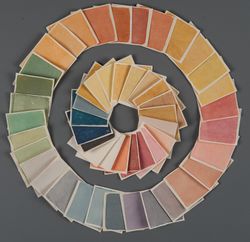Difference between revisions of "Ukiyo-e Print Colorant Database"
| Line 80: | Line 80: | ||
*[[Glossary of Ukiyo-e Colorants]] | *[[Glossary of Ukiyo-e Colorants]] | ||
| + | | style="width:300px; text-align:left;" | | ||
<span style="font-size:120%; color:#4682B4"><b>K</b></span> | <span style="font-size:120%; color:#4682B4"><b>K</b></span> | ||
*[[:Category:Torii Kiyohiro (鳥居清広) active 1737–1776|Kiyohiro, Torii]] | *[[:Category:Torii Kiyohiro (鳥居清広) active 1737–1776|Kiyohiro, Torii]] | ||
| Line 105: | Line 106: | ||
*[[:Category:Katsukawa Shunsho (勝川春章) 1726–1792|Shunsho, Katsukawa]] | *[[:Category:Katsukawa Shunsho (勝川春章) 1726–1792|Shunsho, Katsukawa]] | ||
| + | | style="width:300px; text-align:left;" | | ||
<span style="font-size:120%; color:#4682B4"><b>T</b></span> | <span style="font-size:120%; color:#4682B4"><b>T</b></span> | ||
*[[:Category:Katsushika Taito II (葛飾戴斗) active about 1810–1853|Taito II, Katsushika]] | *[[:Category:Katsushika Taito II (葛飾戴斗) active about 1810–1853|Taito II, Katsushika]] | ||
| Line 111: | Line 113: | ||
*[[:Category:Utagawa Toyokuni I (歌川豊国) 1769–1825|Toyokuni I, Utagawa]] | *[[:Category:Utagawa Toyokuni I (歌川豊国) 1769–1825|Toyokuni I, Utagawa]] | ||
*[[:Category:Ishikawa Toyonobu (石川豊信) 1711–1785|Toyonobu, Ishikawa]] | *[[:Category:Ishikawa Toyonobu (石川豊信) 1711–1785|Toyonobu, Ishikawa]] | ||
| + | |||
<span style="font-size:120%; color:#4682B4"><b>U</b></span> | <span style="font-size:120%; color:#4682B4"><b>U</b></span> | ||
Revision as of 17:34, 14 July 2020
Since 2002, the MFA’s Asian Conservation Studio and Scientific Research department has been conducting research into the colorants used in Japanese woodblock prints, or ukiyo-e prints from the Edo period (1603-1868). Non-invasive techniques that do not require sampling from the prints have been used: X-ray Fluorescence (XRF), Excitation Emission Matrix (EEM) and Fiber Optic Reflectance (FORS) spectroscopies. The results were cross referenced with samples that were formulated and printed using organic and inorganic materials traditionally believed to have been used during the Edo period. Thus far, over 800 prints have been analyzed.
This Ukiyo-e Print Colorant Database is an effort to begin collating the analytical results of colorants used in Japanese woodblock prints from the Edo period (1603-1868) into one location that is accessible to all researchers. It currently focuses on prints from the MFA’s collection from 17XX-18XX. It does not yet cover the whole breadth of colorants used, such as the aniline based colorants, but we hope to continue to expand the database.
Colorants
A list of colorants detected so far in this research. Click to see examples of the printed colors, spectra, and a list of analyzed prints. More on the data.
|
Blue Red |
Yellow Brown Purple |
Green Black White |
Mica Metallic |
By Artist
|
B E H |
K |
M S |
T
|
Bibliography
A list of publications and resources on the identification of colorants in Japanese woodblock prints.
About the Collection
The MFA has over 50,000 Japanese prints and approximately 3,000 titles of illustrated books covering the Edo period (1603-1868) to the present. The Japanese woodblock print collection spans the Edo period from its birth to color printing to its height as a commercial product and to its end in the Meiji period (1868-1912). It also covers a wide breadth of artists working at the time as well as multiple impressions and editions making it also a strong study collection. Collections from prominent Bostonians such as William Sturgis Bigelow, Denman Ross, and the Spaulding brothers form the basis of the collection. The William S. and John T. Spaulding Collection with over 6,000 prints is a unique study collection that has not been exhibited, as stipulated by the Spaulding brothers since its donation in 1921.
Acknowledgement
The colorant research comes out of a long collaboration between the Asian Conservation Studio and Scientific Research department. We would like to thank the many volunteers who contributed to this research. We are also grateful to Richard and Jo-Ann Pinkowitz for donating to this database project which allowed us to bring the ukiyo-e colorant database online.

